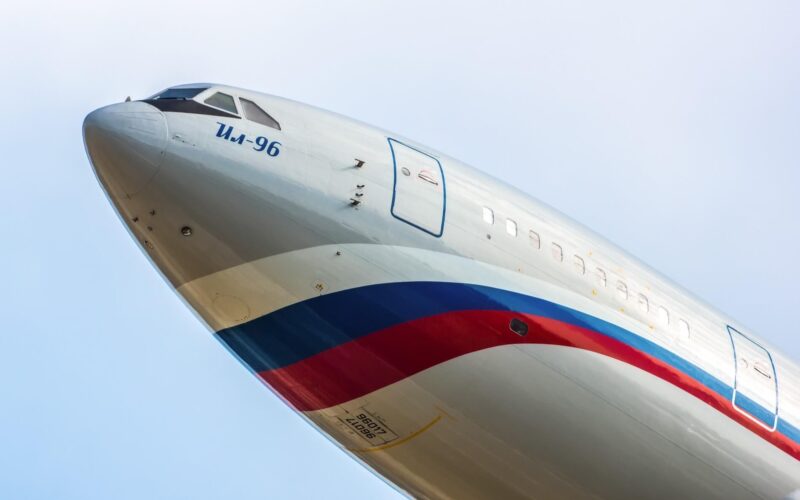There are two wide-body airliners currently under development in Russia: new, sleek Russian-Chinese Craic CR929 and… Ilyushin Il-96-400M, a deep modernization of Soviet-era four-engine beast. Why are Russians digging the old Camber back from the grave?
The Ilyushin Il-96 was designed in the mid-80s and first flew in 1988. It was a redesign of Il-86 Camber, the Soviet answer to Boeing 747 from the early 70s, with new engines and new wings. Range- and passengers-wise intended to occupy the same niche as Boeing 767, it never showed its full potential, unwanted by Russian airlines and unable to compete on the international market.
Nevertheless, the aircraft remained in production, with Ilyushin rolling out one or two aircraft every second year up until the present time. 30 units were produced between 1988 and 2019. Those that went to Aeroflot and various other Russian airlines were mostly decommissioned, while the remainder still serve with Air Force, as Russian “Doomsday planes”, or carry high-ranking officials, including the president Vladimir Putin (several still fly with Cubana airlines too).
With the arrival of the new generation of Airbus and Boeing wide-body twinjets, Il-96 was hopelessly outdated, and there already were plans to stop its production in 2009, as well as in 2013. But it went on, scoring new (yet unrealized) orders with Cuba and Venezuela, for one simple reason: there was no alternative. Neither for Russia, nor for the countries that could not or did not want to buy Western aircraft for their governmental wide-body needs.
Light from the East
It all changed in 2014, when Russia and China signed a cooperation agreement. CRAIC, a joint venture of UAC and COMAC was created, and just two years later the world got a glimpse of the CR929 – eastern rival to Boeing 777 and 787, as well as Airbus A330 and A350.
At first, the work went smoothly, with China eager to reconquer its internal market from foreign-made wide-bodies, as well as acquire Russian competences and technologies. Besides sharing the costs of the development of Il-96’s replacement, Russia also wanted to tap into Chinese market, as the internal one was too small to warrant a multi-billion investment.
And so, the course for the collision was set. Russia did not want to share its know-how and then be left out of the only possible market; China did not want to develop the costly plane and then be forced to buy it from Russia. By mid-2020, the squabble between the two countries got serious enough to cause delays, pushing the first deliveries of CR929 further and further.
As the joint project faced turbulence, it became apparent that either a complete replacement or at least an interim measure was needed. Although at first it might appear that Russia dusted off its old plans for modernized Il-96 then and there, it is not entirely correct.
From backup to the front
Those plans were already in place in 2015, when the CR929 had just entered development and did not even have a name. The new twinjet could not possibly enter into service before the mid-2020s, so it was imperative to continue the production of 80s vintage Il-96 for at least a while. Ilyushin had been already converting the base version Il-96-300 to upgraded Il-96-400 since 1997, but only freighter versions (Il-96-400T) were produced so far, with longer fuselage and barely anything else.
In 2016, the Russian government issued 2.4 billion rubles ($30 million) to the development of re-engined, passenger-adapted Il-96-400 freighter, hoping it to take to the skies by 2019, thus retaining at least some form of wide-body production before the CR929 gets sorted out.
The same year, the Il-96-400M ran into a problem, customary for almost all Russian and Soviet airplanes. At first, the government announced that the modernized plane would be powered by four PD-35s, next-generation engines intended for the CR929. But those, even in the best of circumstances, would not be available until 2024 (later it got delayed to 2028), way too late for an interim measure. Later the same year, it was changed to the PD-14M, which was already set to be carried by the MC-21. But that one, although available, was definitely not powerful enough.
Finally, Ilyushin settled for the PS-60A3M: yet another modernization of the PS-60, the same engine that powered the Il-96 since the 80s. It was upgraded to fit modern emission and noise standards, and to get rid of Pratt & Whitney-made components, used on its earlier versions.
But these developments were rather low-key, overshadowed by the CR929. That was until mid-2020, when the star of the reemerging Russian aviation industry got stopped in its tracks, as described above. And then, the Russian media turned its attention to the Il-96-400M, the prototype of which was slowly being assembled in Voronezh.
Although in September 2020 its completion was delayed to 2021, there is no doubt that the more problems the CR929 faces, the more importance Russians will assign to the Il-96-400M. For very least, it will continue Il-96’s path of a couple aircraft per year; at the most, if the conflict with China does not resolve itself, the new-old wide-body will be forced to take the position of the flagship of Russian aviation industry.

